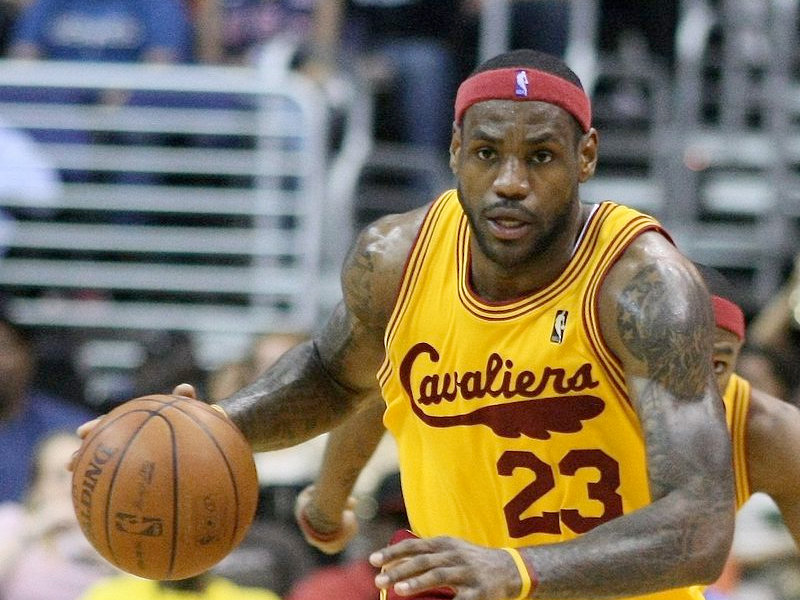LeBron James turned 30 on Dec. 30.
He missed the game that night with the Cleveland Cavaliers with knee soreness. Then, it was announced he would miss two weeks of play with pain in the knees, and the back.
This really should come as no surprise to anyone, even in Cleveland’s front office.
Up until now, James is averaging 37.5 minutes per game, which is right on line with his season averages since 2011-12. He’s shooting at about the same rate, too but is making just 8.8 field goals per game – the lowest rate since his rookie year in 2003-04.
- His field goal percentage (48.8 percent) is at his lowest since 2007-08. His two-point field percentage (52.7 percent) is its lowest since 2006-07. His free throw percentage (74.3 percent) is his lowest since 2007-08.
- His rebounding rate (5.3) is his lowest since his rookie season. His points per game (25.2) is his lowest since his rookie year as well.
- His player efficiency rating of 25.0, which remains well above league average, is his lowest rate since 2006-07.
So, why?
Well, James is 29 games into his 12th season and he has logged 34,364 career minutes in the regular season.
Ah, the "minutes" question. Fans, I’m sure, are tired of it. Who manages minutes, you say, especially when guys are young? Even one Western Conference scout I talked to doesn’t quite buy into that idea.
But it’s not just the minutes. It’s what they mean: time.
Let’s take a random look at some players who James has been compared to, in some capacity (style, body type, etc.).
Michael Jordan
"Air Jordan" didn’t reach the 34,000th minute of his NBA career until he was 34, his 13th season (In between, Jordan missed 64 games due to injury in his second year and another 147 to retirement). Jordan retired again after that year for another three seasons before coming back again at age 38. In his final two seasons, Jordan averaged career lows in points and field goal percentage.
Kobe Bryant
Like James, he reached the 34,000-minute mark the year he turned 30 as well, his 13th NBA season, in 2008-09. Through that year, Bryant averaged 25.1 points per game and shot 45.5 percent. In the five-plus years since then, Bryant has missed 113 games and has averaged 26.3 points per game while shooting 44 percent – and he’s averaging two more shots per game than his previous 13-year average.
Elgin Baylor
Baylor never reached the regular season 34,000-minute mark in his 14-year career.
Larry Bird
"Larry Legend" didn’t crack the 34,000-minute plateau until his final regular season in 1991-92, his 13th year. Now, Bird’s body was ravaged by injury long before – but what’s interesting is that he hit the 33,547-minute total after the 1987-88 postseason, his ninth year. To that point, Bird averaged 79 games played per season. After that, he missed 142 games over his final four years.
Julius Erving
"Dr. J" surpassed the 34,000-minute mark when he was 32, in his 12th season. Through that year, Erving averaged 25.6 points, and shot 50.9 percent from the field. He played four more years, missing 39 total games, averaging 19.4 points and shooting 49.1 percent.
Elvin Hayes
A similar body-type at 6-feet, 9-inches, 235 pounds, Hayes passed the 34,000-minute mark in just his 10th season in 1977-78, and through that first decade he shot 44.8 percent and averaged 23.9 points per game. After that season, Hayes played six more years. His shooting percentage increased (46.4 percent) but his points per game fell to just 16 per game.
Karl Malone
The 6-9, 250-pound "Mailman" passed the 34,000-minute mark at age 33, in his 12th season. He also surpassed the 41,000-minute mark after that year’s playoff run. Through that 1996-97 season, Malone averaged 26.1 points per game on 52.7 percent shooting, along with 10.8 rebounds. In his final seven seasons, Malone remained healthy, but scored 22.9 points on 49.1 percent shooting, and his rebounds dipped to 8.9 per game.
Scottie Pippen
This all-around star passed the 34,000-minute threshold in the regular season when he was 34 and in his 13th season in 1999-2000. Through that year, Pippen averaged 17.3 points, 6.7 rebounds and 5.3 assists per game while shooting 47.8 percent.
That was the last time Pippen played 82 games, however, and over his final four season, Pippen missed 115 games and his averages fell to 10.4/4.7/4.7 and he shot 43 percent.
Perhaps coincidentally, the 1999-2000 season is also when Pippen surpassed the 41,000-career minute mark, including his playoff runs in Chicago, Houston and Portland.
Oscar Robertson
The "Big O" didn’t pass 34,000 minutes until he was 32 and in his 11th season. He averaged 28.3 points (on 48.9 percent shooting), 10.1 assists and 8.2 rebounds over those years. After that, he missed 39 games over his final three seasons in Milwaukee and averaged 15.1 points (45.5 percent), 7.2 assists and 4.6 rebounds.
Now, including his playoff totals, James has logged over 41,000 career minutes of NBA basketball, a number Jordan didn’t surpass until his 13th playoff run and sixth championship at the age of 34.
Bryant may be James’ only true comparison in that regard. Including playoff minutes, Bryant surpassed the 41,000 mark after his 13th season in which he also turned 30.
So, is this a referendum on James’ minutes use, or just age? Aside from Bryant, all of the players mentioned above played in college, and they entered the league at ages 21 or 22. So, of course they were older than James when they hit 34,000 minutes or regular season action.
Perhaps the question isn’t so much how many minutes James has played, but the years.
After a certain point, the body isn’t capable of doing what it once did. In human years, it’s happening "sooner" for James than his contemporaries (age 30 vs. 33, or 34) but in NBA years, it’s happening right on schedule – year 12.
James may yet win another Most Valuable Player (or two) and another championship (or two) but history, and the math, say he’s about to enter the downside of his career in terms of being able to play a full 82 games and average over 37 minutes per game.
What does it mean? It means the reign is ending, as they all do. Now it’s just a matter of time, and how quickly, or slowly, it occurs.
Jim Owczarski is an award-winning sports journalist and comes to Milwaukee by way of the Chicago Sun-Times Media Network.
A three-year Wisconsin resident who has considered Milwaukee a second home for the better part of seven years, he brings to the market experience covering nearly all major and college sports.
To this point in his career, he has been awarded six national Associated Press Sports Editors awards for investigative reporting, feature writing, breaking news and projects. He is also a four-time nominee for the prestigious Peter J. Lisagor Awards for Exemplary Journalism, presented by the Chicago Headline Club, and is a two-time winner for Best Sports Story. He has also won numerous other Illinois Press Association, Illinois Associated Press and Northern Illinois Newspaper Association awards.
Jim's career started in earnest as a North Central College (Naperville, Ill.) senior in 2002 when he received a Richter Fellowship to cover the Chicago White Sox in spring training. He was hired by the Naperville Sun in 2003 and moved on to the Aurora Beacon News in 2007 before joining OnMilwaukee.com.
In that time, he has covered the events, news and personalities that make up the PGA Tour, LPGA Tour, Major League Baseball, the National Football League, the National Hockey League, NCAA football, baseball and men's and women's basketball as well as boxing, mixed martial arts and various U.S. Olympic teams.
Golf aficionados who venture into Illinois have also read Jim in GOLF Chicago Magazine as well as the Chicago District Golfer and Illinois Golfer magazines.







